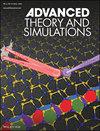Continuum Percolation in Anisotropic Rectangles: The Role of Excluded Area and Average Connectivity at the Threshold
IF 2.9
4区 工程技术
Q1 MULTIDISCIPLINARY SCIENCES
引用次数: 0
Abstract
Percolation is a geometric phase transition in which formerly local clusters spontaneously form a system‐spanning cluster, also referred to as a percolating cluster, facilitating efficient charge transport in conductive materials. Here, a combinatorial approach is developed that integrates a theoretical framework with Monte Carlo simulations to investigate the percolation behavior of penetrable rectangles by systematically exploring the effects of aspect ratio and anisotropic orientation distributions. A theoretical model incorporating a modified expression for the average excluded area is proposed, with both the model and simulations providing rigorous validation and correcting the errors in the original work. With the aid of predictive modeling and simulations, the critical area fraction and bond number have been computed by considering the aspect ratio of rectangles with a specified degree of anisotropy. These results demonstrate that the bond number in isotropic networks remains within 3.6–4.5 across a wide aspect ratio range (1–1000), in strong agreement with established benchmarks reporting convergence to 3.6 for aspect ratios above 20. Using the predicted critical area fractions, the electrical conductivity trends of two‐dimensional (2D) conductive networks are modeled by fitting power‐law curves to the reported simulation and experimental results.各向异性矩形的连续渗流:排除面积和阈值处平均连通性的作用
渗透是一种几何相变,在这种相变中,原局部团簇自发形成系统跨越团簇,也称为渗透团簇,促进导电材料中有效的电荷传输。本文提出了一种将理论框架与蒙特卡罗模拟相结合的组合方法,通过系统地探索纵横比和各向异性取向分布的影响来研究可穿透矩形的渗透行为。提出了一个包含修正表达式的平均排除面积的理论模型,该模型和仿真都提供了严格的验证,并纠正了原始工作中的错误。通过预测建模和仿真,考虑具有一定各向异性程度的矩形的长径比,计算了临界面积分数和键数。这些结果表明,在宽宽比范围内(1-1000),各向同性网络中的键数保持在3.6 - 4.5之间,这与既定基准报告在宽宽比超过20时收敛到3.6的结果非常一致。利用预测的临界面积分数,通过将功率曲线拟合到报告的模拟和实验结果中,对二维(2D)导电网络的电导率趋势进行了建模。
本文章由计算机程序翻译,如有差异,请以英文原文为准。
求助全文
约1分钟内获得全文
求助全文
来源期刊

Advanced Theory and Simulations
Multidisciplinary-Multidisciplinary
CiteScore
5.50
自引率
3.00%
发文量
221
期刊介绍:
Advanced Theory and Simulations is an interdisciplinary, international, English-language journal that publishes high-quality scientific results focusing on the development and application of theoretical methods, modeling and simulation approaches in all natural science and medicine areas, including:
materials, chemistry, condensed matter physics
engineering, energy
life science, biology, medicine
atmospheric/environmental science, climate science
planetary science, astronomy, cosmology
method development, numerical methods, statistics
 求助内容:
求助内容: 应助结果提醒方式:
应助结果提醒方式:


